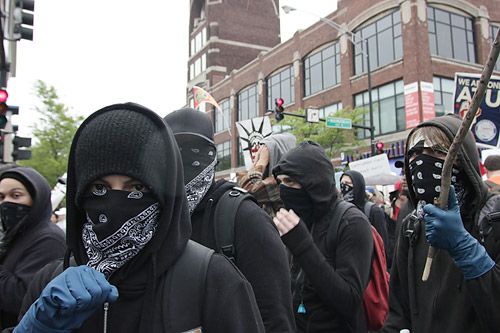
Alleged police infiltrators "Gloves" and "Mo" in a black bloc on May 1 in Chicago. Photo by Marcus Demery.
This is from the Occupied News Wire. It originally appeared in the Occupied Chicago Tribune and at AlterNet.
By Arun Gupta
With the high-profile arrest of activists on terrorism charges in Cleveland on May Day and in Chicago during the NATO summit there, evidence is mounting that the FBI is unleashing the same methods of entrapment against the Occupy Wall Street movement that it has used against left movements and Muslim-Americans for the last decade.
In Cleveland the FBI announced on May 1 that “five self-proclaimed anarchists conspired to develop multiple terror plots designed to negatively impact the greater Cleveland metropolitan area.” The FBI claimed the five were nabbed as they attempted to blow up a bridge the night before using “inoperable” explosives supplied to them by an undercover FBI employee.
Then on May 19, the day before thousands marched peacefully in Chicago to protest NATO-led wars, the Illinois State Attorney hit three men with charges of terrorism for allegedly plotting to use “destructive devices” against targets ranging from Chicago police stations to the home of Mayor Rahm Emanuel. Defense attorneys for the Chicago activists claim their clients, like the Cleveland activists, were provided with supplies for making Molotov cocktails by undercover agents in an operation that included the participation of the FBI and Secret Service. This was followed up on May 20 by the arrest of two other men on terrorism charges in Chicago for statements they made, which critics say amount to thought crimes. The Chicago cases are also reportedly the first time the state of Illinois is charging individuals under its post-September 11 terrorism law.
To hear FBI officials describe it, “Law enforcement took swift, collaborative action…to eliminate the risk of violence and protect the public.” To many observers, however, the government itself is the overarching threat, systematically repressing peaceful dissent.
Will Potter, who analyzes FBI entrapment plots in his book Green is the New Red, says the two incidents are “a reflection of an ongoing pattern of behavior from the FBI of singling out political activists and having a direct influence in creating so-called terrorist plots for the purpose of proclaiming a victory in the war on terrorism.” Potter claims, “There have been many other cases like these in which the FBI had a role in manufacturing the plot itself. We’ve seen this time and again with animal rights activists, environmental activists and the anarchist movement.”
Simply put, the Cleveland and Chicago cases appear to be instances of the federal government foiling its own terror plots. Two days before the Cleveland plot was supposedly thwarted, David Shipler, author of Rights at Risk: The Limits of Liberty in Modern America, presciently described in the New York Times the mechanics of the FBI trap about to be sprung. Shipler wrote that FBI terror stings typically begin by targeting “suspects for pure speech” such as comments, emails and “angry postings” on the Internet. The suspects are then “woo[ed] into relationships with informers, who are often convicted felons working in exchange for leniency, or with FBI agents” working undercover. Some suspects are “incompetent and adrift, like hapless wannabes looking for a cause that the informer or undercover agent skillfully helps them find.” Noting that the FBI is “cultivating potential terrorists,” Shipler asked, “would the culprits commit violence on their own?”
That’s what the FBI claims – that it thwarted the deadly plans of Brandon Baxter, 20; Anthony Hayne, 35; Joshua Stafford, 23; Connor Stevens, 20; and Douglas Wright, 26. The plot allegedly began last fall after Doug Wright discussed deploying smoke bombs as a decoy while individuals toppled bank signs from skyscrapers in downtown Cleveland, and evolved with FBI planning into using “C4 plastic explosive devices” to demolish a bridge connecting the Ohio communities of Brecksville and Sagamore Hills.
Stephen Anthony, Special Agent in Charge of the FBI’s Cleveland office, claimed during the May 1 press conference “that at no time during the course of the investigation was the public ever in danger.” So if the public was never in danger, was there ever a threat?
To get to the bottom of the story I traveled to Cleveland shortly after the arrests and interviewed about 20 friends and family members of the “Cleveland 5,” as supporters are calling them. They describe a group of naïve, vulnerable and even desperate individuals that the FBI preyed on. A government informant provided the five with jobs, money, a place to live, a friendly ear, beer, pot, the prescription stimulant Adderall, and most significant, the ideas and means to carry out a plot conceived by the Bureau itself.
The Lost Boys
Friends describe the five – everyone calls them boys or kids – as “quasi-hobos” and on the losing end of society. Lea Tolls, a 46-year-old mother and self-described “Occu-mom,” says, “Except for Connor [Stevens] they were destitute. They are angry, some have mental illnesses, and there is alcoholism and abuse in their families.”
Kaiser, a Cleveland occupier, told me that Doug Wright, the alleged ringleader, was “like a big brother to me. He ran away from his parents when he was 12.” Everyone invariably mentioned Wright was a train hopper, an explanation that accounts for his mangled nose, missing teeth and abrasive manner. Ben Shapiro, 26, an environmental organizer who was active with Occupy Cleveland last fall, said, “Doug was poor. He was angry, had a hard time dealing with people and was short-tempered.” Nonetheless, numerous youth said Wright was protective of and cared about them and was a hard worker. Zachy, a lanky 21-year-old who hung out with the five, says, “Doug actually did shit. He was running logistics at the Occupy camp. He was the one that knew how to tie knots and put tarps on the tents.”
The story is the same for the others: lost souls wanting to help others. Most Cleveland Occupiers were wary of Anthony Hayne, the oldest of the accused, labeling him a “con man,” “swindler” and “schemer.” Lea Tolls defended him, stating, “Tony was an addict, and we treated him accordingly.” Others added that Hayne’s mother died a week before Occupy Cleveland began. Jonnie Peskar, 22, a member of Occupy Cleveland, says one night another defendant, Brandon Baxter, told him his life story, “He grew up in violence. He and his dad would fist fight. Brandon talked about how he was traumatized growing up.”
Gloria, a friend of Brandon Baxter’s, called him “an absolute joy to be around. He wants to help everyone he comes in contact with.” But he also suffered from “horrible depression” and tried to kill himself in February by jumping off a bridge before being talked down by cops, she claimed. “He spent weeks in the hospital from the suicide attempt.” As for Joshua Stafford, who is known as Skelly, his mother anonymously told the media of a troubled life, saying he had been “in and out of hospitals, prisons, jails. He’s just been a troubled soul since he’s been born.”
Joshua Stafford and Brandon Baxter are also described as highly impressionable. Tolls says Stafford, “would have done anything anyone told him to, just to have friends.” Peskar says Brandon Baxter admitted to him, “‘I’m easily brainwashed because I was pulled into being a Neo-Nazi.’ Brandon was in a very confused state. He always contradicted himself. He didn’t know what he wanted.”
Of the five, only Brandon Baxter and Connor Stevens appear to be in contact with their families. Curious as to how Stevens was caught up in the trap, I sat down with his family in their modest ranch house in the suburbs of Cleveland to hear of a thoughtful and passionate young man trying to surmount life’s obstacles on the path to adulthood. Stevens’ mother Gail describes her son as “extremely intelligent” although “school didn’t engage him.” Connor Stevens dropped out his junior year. In his sophomore year, Stevens and some friends founded a social justice group called “Fighters for Freedom” that was quickly shut down by the school administration. He was also elected class president, but was not allowed to serve because of a low grade point average. When he was 16 he told his family he was gay, which his siblings said neither surprised nor fazed them.
Gail also spoke of family troubles that affected Connor and her other children deeply – her mother and sister passing away in quick succession, followed less than a year later by her husband James running afoul of the law in 2001, which resulted in more than two years in prison for him and the dissolution of their marriage. Gail went from a stay-at-home mom to the sole breadwinner and had to handle the stress of moving her family into her father’s house.
Occupy gave Connor Stevens a sense of belonging. Gail says, “I was excited for him. There was something he could actually be part of in Cleveland.” In early 2012 he began to say “he wanted to be a pastor. He felt he was being called.” She read a letter Stevens sent her from the Corrections Corporation of America facility near Youngstown, Ohio, where he is being held. He wrote:
“I am in good spirits and feel at the top of my game physically, mentally, spiritually. … I have great faith and do not underestimate the power of prayers. The bible I’m reading, the New American, in which I’ve been focusing on the Old Testament, speaks constantly of the Lord’s uplifting the oppressed, siding with the poor, the downtrodden, the widows and the orphans. I believe God is on our side. The scripture you quoted from Jeremiah is very fitting. And just before I came down to our last visitation … I read Psalms 27:1. This is my rock, this passage. It conveys everything.”
The Plot Begins
Cleveland 5 supporters claim that Connor Stevens and possibly others were threatened to participate in the plot. Others interpret as a threat a comment in the FBI affidavit in which the informant tells the group they are “on the hook” for the explosives. Interviews with more than a dozen Cleveland activists also provide evidence that a possible FBI asset by the name of Ryan is still floating around Cleveland and is cryptically mentioned just once as “Ryan LNU” (Last Name Unknown) in the criminal complaint against the five.
The FBI plot begins on October 21. On that day the city of Cleveland announced it was shutting down the two-week-old occupation in the downtown Public Square. Organizers say Occupy Cleveland held a rally on Oct. 21 more than 500 strong, including nonviolent civil disobedience, while choosing to roll up dozens of tents in the camp so as to save its equipment from imminent confiscation by the police.
Also on Oct. 21, the FBI’s “Confidential Human Source” (CHS), subsequently identified as Shaquille Azir, made contact with Douglas Wright. The affidavit states: “Based on an initial report of potential criminal activity and threats involving anarchists who would be attending an event held by a protest group, the Cleveland FBI directed the CHS to attend that event.” That night, the FBI report continues, while most occupiers were engaged in protest, a group of seven men “was constantly moving throughout the crowd expressing displeasure at the crowd’s unwillingness to act violently.”
Numerous friends of the five dispute this account, saying violence was never raised. Because there is no audio recording of the encounter, as there are for many others, the FBI claims could easily be fabricated, which would mean the basis for the investigation was spurious. People present say there was a tactical dispute between “do-it-yourself” punk kids, which the five identified with, who wanted to keep the camp going, and more mainstream, college-educated occupiers who agreed to take down dozens of tents while staging a nonviolent civil disobedience action to demonstrate support for free speech rights. Zachy and Natalie, friends of the five, say the punk kids were disillusioned with both the decision to end the occupation and what they saw as an ineffectual protest, but no one discussed violence.
‘Silly Kid Things’
Zachy says, “About a week after the collapse of tent city on Oct. 21, we created a group called the Revolutionary People’s Army. We were being romantic. We were drunk and high … Doug, Connor, Brandon, Joshua and Tony were all involved in the RPA. There were a couple of serious meetings and it turned into spray painting Guy Fawkes masks, ‘Rise Up’ and ‘RPA’ and ‘circle A’ anarchist symbols around town. We also plastered ‘Wake Up’ with circle A and Occupy stickers. RPA was real tongue-in-cheek. It was silly kid things.”
Tolls calls them “boys playing cowboys and Indians with fireworks and spray paint,” adding, “They were trying to empower themselves and passionately wanted to change their world. Occupy gave them hope. They were targeted by the FBI and culled from a peaceful group. They were guided toward this by individuals who provided the means and motivation. They didn’t have these violent actions in them.”
It was from these childish antics that the FBI claims that Doug Wright conjured up the initial plot – deploying smoke bombs as cover as while toppling bank signs from buildings such as the Key Bank tower. Friends of Doug Wright laugh at the allegations. They mention that with Wright’s smashed-up face and punk attire he would not even be allowed into the building, much less be able to scale the 947-foot-tall skyscraper and blast off the enormous red key affixed to the outside.
Ben Shapiro, who is highly regarded in the activist community, says he noticed suspicious activities he interprets as police disruption. “Certain people were actively trying to isolate the Cleveland 5 from other organizers last fall by spreading rumors they were FBI agents.” Additionally, says Shapiro, during the first few weeks of the occupation at the centrally located Public Square, “We saw people in strange white vans circling around the square, conducting surveillance. They were parked in an area downtown where anyone else would have been towed or ticketed within minutes.”
After the encampment ended, Shapiro says he was concerned about the punk kids and cautioned them against engaging in unsafe behavior. “They had every reason to be frustrated – there were poor group dynamics and an inability to reoccupy the square.” At the same time, he adds, “They were good kids and were coming up with elaborate plans on how to hide their tents in backpacks.” Shapiro says the activity wasn’t a strategic answer to the loss of space, but “it was very spirited.”
In hindsight, says Shapiro, there was “evidence of narcs … People spreading rumors, isolating members of the community, providing money, transportation and space.” He emphasizes he is referring not only to Shaquille Azir, but to the shadowy Ryan as well. When he heard news of the arrests, Shapiro says, “I saw the list of names. I saw this group of kids that had been targeted was now entrapped. It seems so fabricated.”
Zachy says during the next few months the five except for Anthony Hayne (whom he said was serving a jail sentence) would regularly stop by the one remaining tent downtown to pull night shifts. Zachy adds that in early November Ryan tried to recruit him to meet Shaquille Azir, telling him, “This guy is buying us breakfast and will give us a house with no strings attached.” Zachy says he was suspicious and declined the offer. Despite multiple claims that Ryan is in contact with Azir and even recruiting people to meet him in the fall, Ryan is only mentioned once in the affidavit in February 2012.
Over the winter, according to the FBI affidavit, the contact between Shaquille Azir and Doug Wright is sporadic. Azir and Wright reconnect in mid-February at the same time Occupy Cleveland rents a warehouse as a crash pad for occupiers who were maintaining a presence at the tent.
Anarchist Romper Room
In mid-May, I ventured to the red-brick warehouse dubbed the “fortress.” Entering the decrepit building was like walking into an anarchist Romper Room: tents pitched indoors, graffiti, belongings strewn about, people dozing mid-day, dirty dishes and pungent toilet odors. It was here that Brandon Baxter, Connor Stevens, Tony Hayne and Joshua Stafford reassembled. I joined half a dozen people around a table as they puffed hand-rolled cigarettes incessantly. They were clearing out as the lease was up the next day. Right off the bat, Zachy said, “A lot of us had never lived in a communal situation. This was the first time living away from our parents. Dishes were always a fight. We’re a bunch of uneducated kids.”
When the topic of cleaning came up, Rachel jumped in, “I got the name ‘mother hen’ for always complaining. ‘Come on guys, clean this trash up.’”
The discussion repeatedly circled around to Ryan. The warehouse crew expressed suspicion because Ryan appeared in mid-October, saying he drove up from Florida, but soon had connections to Azir, whom virtually no one ever met outside the five. They also mentioned Ryan would take regular road trips in his car and claim his steady source of income was via his parents wiring money to him.
In April everything comes to a head. Jonnie Peskar said Doug Wright seemed excited one day in early April. He says Wright told him, “Today is going to be a really good day. My boss has some joints waiting.” Peskar continues, “Shortly thereafter Doug asked Connor if he wanted work. They told me multiple times, ‘It’s a really cool job. He gives us beer. He smokes us out.’”
Gail said this is the first job her son ever had in his life, the first time he made money – five bucks an hour. She showed me text messages Connor Stevens sent her at the time:
“A long day of labor for me. Made $60, long day 9:30 am to 9:30 pm … If I wanna do it again, I gotta get up at 9 tomorrow. Lifes rough.”
“I kinda feel like an ant”
“My friend doug got me the job. The $ goes fast. Turned out not to have work today. Still needa get footwear.”
As the alleged plot to blow up the bridge takes shape, the warehouse members say Shaquille Azir would swing by the warehouse in the morning to pick up the boys to do home repairs, but he would sit in the car and never interact with anyone else. Rachel says she asked Doug Wright for work with Azir, but was rebuffed, as were others who offered their services. Friends of Baxter’s say Wright hooked him up with work with Shaquille April.
Peskar says jobs weren’t the only thing Azir was hooking them up with. Baxter admitted to him that he was taking Adderall, a widely abused prescription stimulant. Peskar says, “Connor was also taking it, and mentioned, ‘I have a connect for Adderall.’ Both Wright and Baxter said the connection for the Adderall was Azir. I asked Baxter where he got it from, and he said ‘Doug’s boss.’”
The warehouse was also buzzing with rumors that something was afoot. One individual told me that someone asked him, “Did you hear that Doug is trying to blow up a bridge?” The individual said, “I literally laughed it off. I said Doug is a moron. He doesn’t know how to do anything like that.” Another person fingered Ryan as the source of the rumors. Ryan allegedly told them in early April, “The warehouse is going to get raided. There are people who are going to do something dangerous with explosives. It’s sitting at a house.”
I pointed out to the warehouse group that after such a dramatic incident like the arrest of the five on terrorism charges, there is a tendency to see everything that happened over the previous months in a paranoid light. Julia Boyd, who is active with Occupy Cleveland, says, “A lot of the detrimental effects of this is everyone is suspicious of everyone else.”
I suggested maybe Ryan is just crazy, not an FBI operative. One person got Ryan on the line and put him on speaker phone. After a minute of small talk, Ryan claimed someone they all knew had been arrested. Everyone was concerned this signaled a wider sweep of activists on terrorism charges. Except hours later I met up with the person in question who was never arrested and was adamant that Ryan is an FBI operative. I was able to find Ryan’s number and called him. A male answered who claimed he wasn’t Ryan and hung up after a minute. Subsequent attempts to contact Ryan by phone were unsuccessful.
It remains to be seen if Ryan is on the FBI payroll or just mentally unhinged, but lawyers told me that at minimum Ryan would be of interest for the defense lawyers for the five and it might be possible to determine if he is a paid agent. Another lawyer, who has been handling high-profile political cases like the Cleveland 5 for nearly 40 years, mentioned that in addition to the use of undercover agents and informants, the FBI employs “agent provocateurs” to infiltrate and discredit political movements, changing the name of programs to make it appear as if it has reformed its underhanded ways.
In the case of the five Chicago activists who have been swept up on terrorism charges, defense attorneys charge that two police informants nicknamed “Mo” and “Gloves” were the masterminds. In the post-9/11 era the FBI has up to 60,000 informants and spies around the United States, according to an expose by Mother Jones. The FBI cut its teeth as a repressive police force during the Red Scare after World War 1, raiding homes and deporting thousands of legal foreign-born radicals in the labor, anarchist and socialist movements. After World War II, the FBI destroyed thousands of lives and decimated the left during the McCarthy Era. The FBI famously spied on Martin Luther King, Jr., during the 1960s and at one point thousands of agents were devoted to disrupting and sabotaging the anti-Vietnam War, student and black liberation movements.
During the 1980s the FBI spied on Central American solidarity activists. Since Sept. 11 the FBI has snared hundreds of Muslim Americans in cases involving informants who supplied the ideas, motivation and means for a terrorist plot. In recent years the FBI has termed “animal rights and environmental extremists,” as well as anarchists as some of the main domestic terrorist threats. It has used infiltrators, most infamously one code-named Anna, to entrap environmental activists. In 2008, the FBI sent a snitch by the name of Brandon Darby on a fishing expedition, and he managed to cajole and push two Austin, Texas youth into agreeing to make Molotov cocktails at the Republican National Convention in St. Paul, Minn. These were all political cases as are the two against the Cleveland 5 and the Chicago group.
The fact that the FBI sprang cases during the biggest Occupy events this year – May Day and NATO – indicates it has the Occupy movement in its sights. They are hardly the only ones. Reams of federal government documents secured by the Partnership for Civil Justice Fund reveal widespread government surveillance and information gathering on the movement ranging from the Department of Homeland Security to the Pentagon. The public interest legal organization asserts that the documents regarding Occupy Wall Street “scratch the surface of a mass intelligence network including Fusion Centers, saturated with ‘anti-terrorism’ funding, that mobilizes thousands of local and federal officers and agents to investigate and monitor the social justice movement.”
For now the Cleveland 5 are languishing in jail. Connor Stevens and Doug Wright have been on suicide watch according to those who visited them. Brandon Baxter wrote in a letter dated May 19, “So Skelly was just dragged out of his cell a bit ago, He wrote ‘They all want me to DIE’ all over his walls, They said they’ll bring him back, but he may be a suicide watch for awhile.”
Their trial has been set for September 17, 2012, the one-year anniversary of Occupy Wall Street, after the defense objected to Sept. 11, which was originally scheduled as the trial start date.
Summing up the feeling of many supporters, Lea Tolls says, despite their hard backgrounds the five “all have good hearts and souls. I tried to give them comfort, guidance and stability. I used to call them my lost boys, and now they’re very lost. The richest country in the world can’t support them, give them healthcare, a proper education and they end up falling through the cracks. Instead of helping them, the FBI targets them for something nefarious and violent. It’s just disgusting that the government uses them towards this end.”
Arun Gupta is a founding editor of The Indypendent newspaper. He is writing a book on the decline of American Empire for Haymarket Books.

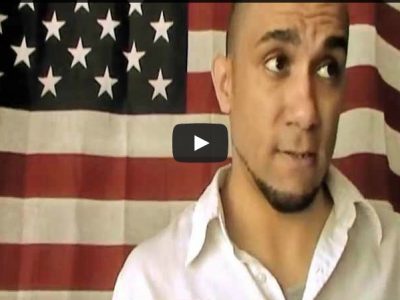
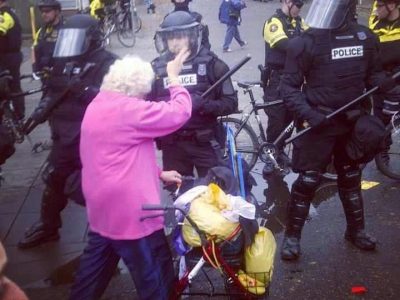
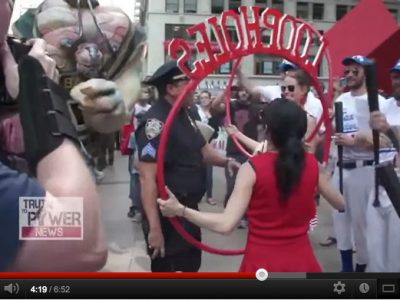
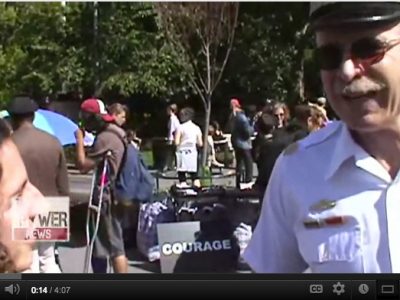
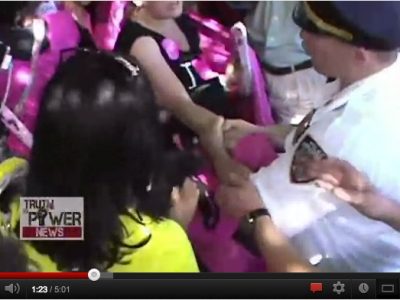
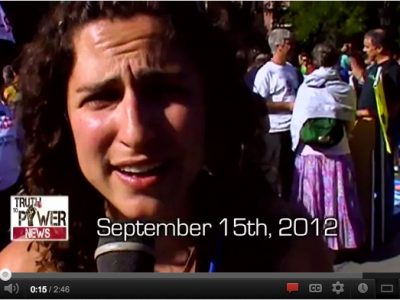
3 comments for “Has the FBI Launched a War of Entrapment Against the Occupy Movement?”